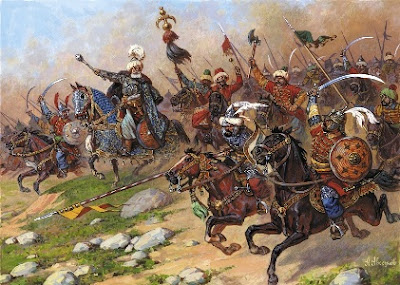Battle of Kosovo
Everyone agrees that the assassin of Murad/Murat (The First)
was a Serb whose personal name was Miloš
(turkified as Milos,) (anglicized to Milosh). But, after that,
identification of the killer begins falling
off the track.
One respected historical source says he was a crazed
camp-follower. Another claims he was a patriotic Serb nobleman. Since he could
have easily been both, we'll just say 'take your pick' -- and move on, to where
a more serious argument looms. Because... when it comes to the question of the
assassin's correct surname, the matter becomes more important to some.
When Stephen Dushan of Serbia died his empire passed into
the hands of his young son Urosh. His vassals soon renounced their allegiance
to him and set themselves up as independent princes. One of these Serb leaders,
Vukashin, who ruled in Serres, combined his forces with sympathetic Serbian
allies and marched northwards towards the Maritza Valley full of hope. But far
from driving the Turks out of Lurope they suffered a great defeat on 26
September 1371 at the battle of Cernomen where all the Serbian leaders were
killed. This battle, also known as the second battle of the Maritza, was called
in the Turkish chronicles 'Sirf sindigi' (the destruction of the Serbs). Murad
I was prudent after his victory and left much of Macedonia and Serbia in the
hands of local chiefs as his vassals. They included a certain Lazar, who,
although connected with the Dushan family did not claim the royal title.
Almost ten years went by before the Turkish advance against
Serbia was renewed. In the meantime they struck at Albania and Bulgaria. So
confused had been the state of Albania that its rulers were used to calling in
foreign troops to aid them against internal rivals, and so it was that the lord
of Durazzo called upon the Ottomans as allies in 1385. The price was vassaldom
and when the fortresses of Croia and Scutari fell to Murad I he handed them
over to his loyal Albanian followers. Elsewhere Thessalonica surrendered in
1387, but Murad I also sought to consolidate his position in Anatolia and took
Konya from the Turkish house of Karaman that same year.
Lazar of Serbia seems to have been stung into action by the
loss of Sofia in 1385, a defeat that was followed in 1386 by the occupation of
the Serbian city of Nis. He was also embarrassed by the use of Serbian vassal
troops in the Ottoman Army, so a combined force of Serbs and Bosnians went to
war and defeated the local Turkish commander. The victorious army grew, swollen
in number by hopeful contingents from Bulgaria, Wallachia, Albania and Hungary.
But swift action by Murad I detached Bulgaria from the league and, as he
marched north to take on Lazar, he was joined by many sympathetic Serbian
nobles.
The resulting armed clash was the famous battle of Kosovo,
fought in June 1389, an encounter that still has tremendous significance in
Balkan politics today. Among all the legends about the battle and its aftermath
three facts stand out. The Ottoman Turks were victorious; Murad I was killed by
a Serb at some point, although not during the actual fighting; and Lazar of
Serbia was captured and executed in revenge. His son Stephen Lazarevic
succeeded him and reigned for many years as a loyal Turkish vassal.


